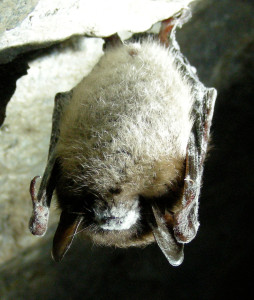 Like any other bat among these small mammals, the pond bat is a free-flier. Its eyesight is poor, but the sense of touch and hearing are very sharp. The special structure of their voice-and-hearing apparatus is adapted to send and receive ultrasound signals. Because of this ultrasound positioning, bats orient in space very well and easily hunt flying insects. They are nocturnal animals preying mainly on nocturnal insects. Pond bats settle near stagnant water bodies or lowland rivers. They appear in the mountains only during their seasonal migrations and wintering. During the day, these bats hide in attics, and sometimes in tree hollows. They winter in crevices and cracks of buildings or in caves. The pond and Daubenton’s bats were observed in the Gdov and some other districts. They hibernate over the winter. The said bats, and also the northern and long-eared bats were discovered in the cave of Piusa in Estonia, five kilometers west of the border of the Pskov Region. The registered hibernation period is six months. All bat species are valuable, since they exterminate many forestry and agricultural insect pests.
Like any other bat among these small mammals, the pond bat is a free-flier. Its eyesight is poor, but the sense of touch and hearing are very sharp. The special structure of their voice-and-hearing apparatus is adapted to send and receive ultrasound signals. Because of this ultrasound positioning, bats orient in space very well and easily hunt flying insects. They are nocturnal animals preying mainly on nocturnal insects. Pond bats settle near stagnant water bodies or lowland rivers. They appear in the mountains only during their seasonal migrations and wintering. During the day, these bats hide in attics, and sometimes in tree hollows. They winter in crevices and cracks of buildings or in caves. The pond and Daubenton’s bats were observed in the Gdov and some other districts. They hibernate over the winter. The said bats, and also the northern and long-eared bats were discovered in the cave of Piusa in Estonia, five kilometers west of the border of the Pskov Region. The registered hibernation period is six months. All bat species are valuable, since they exterminate many forestry and agricultural insect pests.
/ * The photos at lake.peipsi.org are cross-posted from commons.wikimedia.org and are used for familiarization purposes only. No commercial use of the photos is allowed. For more information about to use the photos see the originals on commons.wikimedia.org. /


